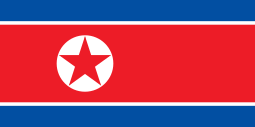Chongjin concentration camp
Chongjin concentration camp (Chosŏn'gŭl: 청진 제25호 관리소, also spelled Ch'ŏngjin) is a labour camp in North Korea for political prisoners. The official name is Kwan-li-so (Penal-labour colony) No. 25. Satellite images show a major expansion of the camp after 2010.
| Chongjin concentration camp | |
| Chosŏn'gŭl | 청진 제25호 관리소 |
|---|---|
| Hancha | |
| Revised Romanization | Cheongjin Je25ho Gwalliso |
| McCune–Reischauer | Ch'ŏngjin Che25ho Kwalliso |
| Chosŏn'gŭl | 청진 정치범 수용소 |
| Hancha | |
| Revised Romanization | Cheongjin Jeongchibeom Suyongso |
| McCune–Reischauer | Ch'ŏngjin Chŏngch'ibŏm Suyongso |
| Part of a series on |
| Human rights in North Korea |
|---|
 |
|
International reactions |
Location

The camp is located in the city of Chongjin in the North Hamgyong province of North Korea. It is situated in Suseong district (Susŏng-dong) of Songpyong-guyok, around 7 km (4.3 mi) northwest of the city center and 1 km (0.62 mi) west of Susŏng River (Susŏngch'on).[1]
Description
Chongjin camp is a lifetime prison. Like the other political prison camps it is controlled by the state security agency.[2] But while the other camps include many vast prison-labour colonies in remote mountain valleys, Chongjin camp is only one big prison building complex similar to the reeducation camps.[3] The camp is around 500 m (1500 ft) long and 500 m (1500 ft) wide, surrounded by high walls and fences and equipped with guard towers.[4] The number of prisoners is estimated to be between 3000[5] and 5000.[6]
Purpose
The main purpose of the camp is to isolate political prisoners from society.[7] The prisoners are exploited for hard labour to be performed in the prison factories. Popular North Korean consumer products like Kalmaegi bicycles[8] are manufactured by prisoners using hand tools.[9]
Human rights situation
Ahn Myung-chul (a former prison guard in Hoeryong concentration camp) described Chongjin camp as a top-level political prisoner camp,[10] therefore harsh conditions can be assumed.[11]
Camp expansion
Detailed analysis of satellite images shows a major expansion of the camp perimeter in 2010.[12] The size of the camp increased 72 percent, from 580 m2 (6,200 sq ft) to now 1,000 m2 (11,000 sq ft). Along the new fence line 17 additional guard posts were erected. In the eastern part of the new perimeter several new buildings were erected from 2011 to 2013, possibly to be used as prisoner housing.[13]
Prisoners (witnesses)
There are no first-hand witness accounts on the camp; however, there are some reports by North Korean defectors on prisoners in Chongjin camp.[14][15] Lim Kook-jae, a South Korean abducted to North Korea in 1987 aboard the Dong Jin 27, died in Chongjin camp, according to a human rights organization.[16] Many pastors and presbyters, dissident Korean-Japanese and people expelled from Pyongyang with their families are detained in Chongjin camp, according to the 9th International Conference on North Korean Human Rights and Refugees.[17]
See also
References
- "The Hidden Gulag – Exposing Crimes against Humanity in North Korea's Vast Prison System (satellite imagery, p. 223 – 224)" (PDF). The Committee for Human Rights in North Korea. Retrieved May 8, 2012.
- KINU White paper on human rights in North Korea 2009 (Chapter G. Human Rights Violations Inside Political Concentration Camps (Kwanliso), page 131)
- "Political Prison Camps in North Korea Today (p. 108)" (PDF). Database Center for North Korean Human Rights (NKDB), July 15, 2011. Archived from the original (PDF) on February 28, 2013. Retrieved May 8, 2012.
- One Free Korea: Camp 25 in Chongjin (satellite images with annotations)
- “Political Prison Colonies in North Korea: System and Repercussions”, 9th International Conference on North Korean Human Rights and Refugees, Melbourne, March 20, 2009 (page 27)
- "Political Prison Camps in North Korea Today (p. 65)" (PDF). Database Center for North Korean Human Rights (NKDB), July 15, 2011. Archived from the original (PDF) on February 28, 2013. Retrieved May 8, 2012.
- KINU White paper on human rights in North Korea 2009 (Chapter G. Human Rights Violations Inside Political Concentration Camps (Kwanliso), page 125, page 127)
- Andrei Lankov: North of the DMZ, essays on daily life in North Korea (McFarland Publishers, 2007), page 144
- KINU White paper on human rights in North Korea 2009 (Chapter G. Human Rights Violations Inside Political Concentration Camps (Kwanliso), page 125)
- KINU White paper on human rights in North Korea 2009 (Chapter G. Human Rights Violations Inside Political Concentration Camps (Kwanliso), page 127)
- "North Korea: Political Prison Camps". Amnesty International. May 4, 2011. Retrieved November 11, 2013.
- "North Korea expanding gulags, satellite images show". The Telegraph. February 26, 2013. Retrieved February 26, 2013.
- "North Korea's Camp No. 25" (PDF). U.S. Committee for Human Rights in North Korea & Digital Globe Analytics. February 25, 2013. Retrieved February 26, 2013.
- KINU White paper on human rights in North Korea 2009 (Chapter G. Human Rights Violations Inside Political Concentration Camps (Kwanliso), page 118, page 136)
- Amnesty International 2004: Starved of rights, section 6.5 The impact of famine and the food crisis on woman
- “Abducted South Korean Dies in a North Korean Political Prison Camp”, The Daily NK, October, 14 2008
- “Political Prison Colonies in North Korea: System and Repercussions”, 9th International Conference on North Korean Human Rights and Refugees, Melbourne, March 20, 2009 (page 27)
External links
- Committee for Human Rights in North Korea – Overview on North Korean Prison Camps with Testimonies and Satellite Photographs
- Database Center for North Korean Human Rights (NKDB) - Political prison camps in North Korea today
- Digital Globe Analytics - Detailed satellite image analysis of North Korea's Camp No. 25
- Korea Institute for National Unification - White paper on human rights in North Korea 2011
- One Free Korea - Camp 25 at Chongjin (with satellite photographs)
- The Daily NK: The Hub of North Korean News – News about North Korea and human rights